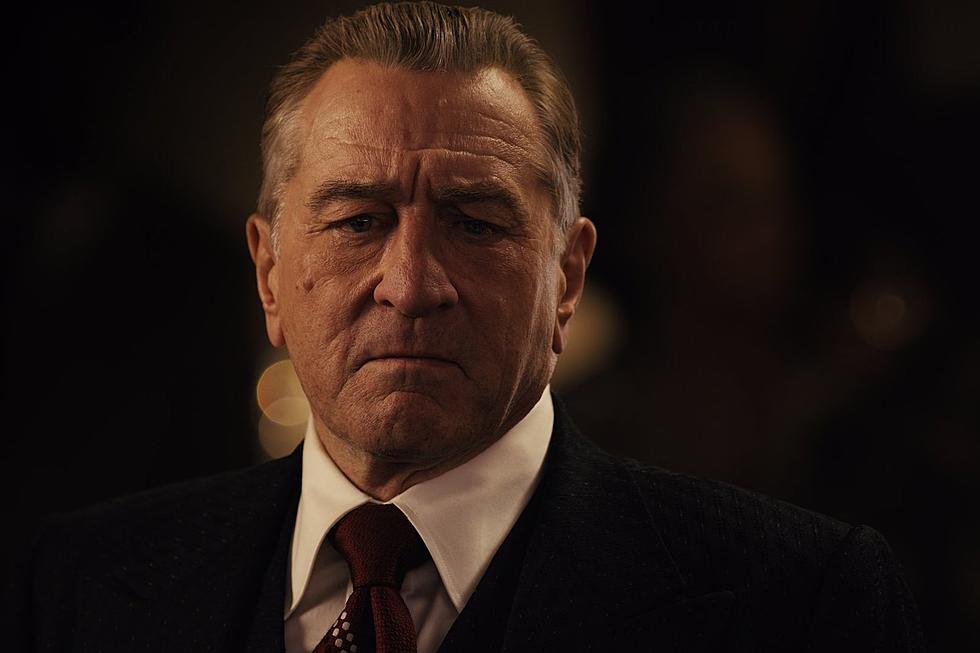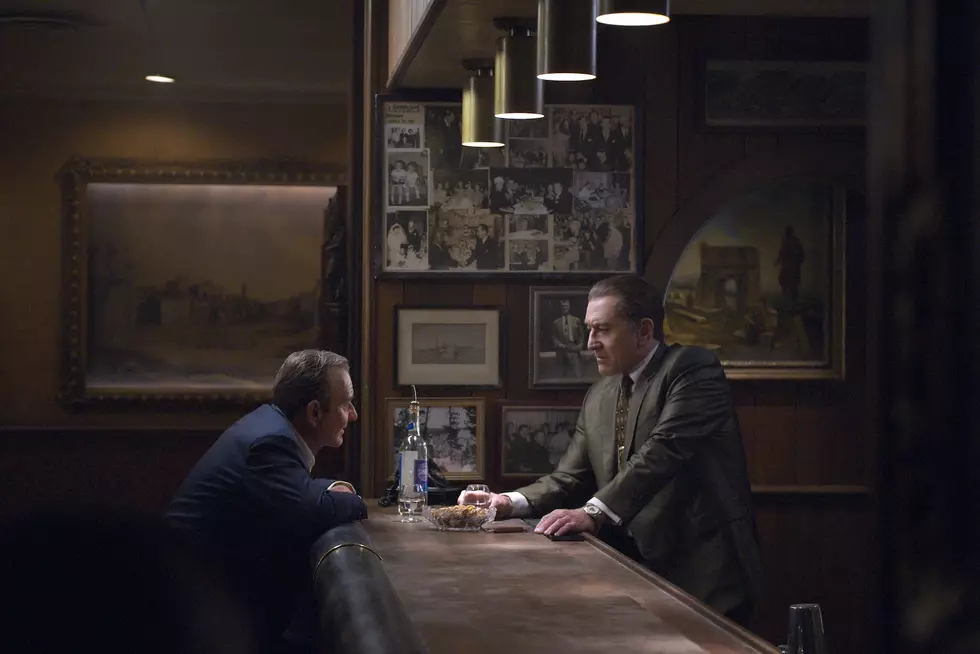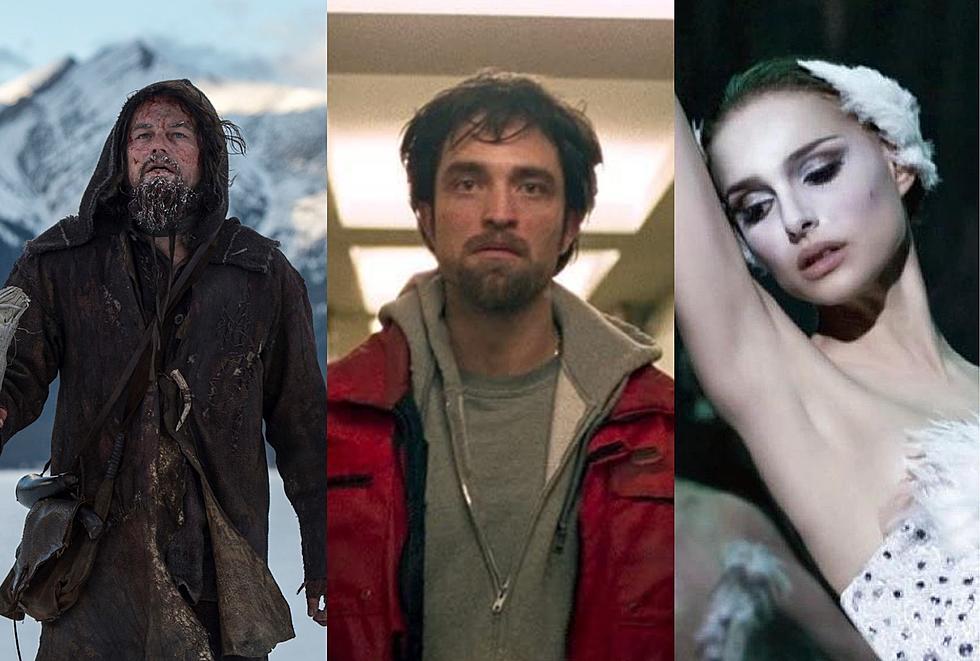
‘The Irishman’ Review: Scorsese and De Niro Come to the End of the Road
Frank Sheeran was not a house painter — at least not in the vocational sense. In the criminal underworld, painting a house means whacking someone and, in the process, splattering their blood all over the walls and floor. As a young man, Frank was a truck driver by trade. That, after “house painting,” is probably the thing Frank does most in The Irishman — he drives. And all the driving Frank does throughout the film becomes The Irishman’s central metaphor for his (and our) journey through life.
This massive 209-minute film, which feels like a career summation for director Martin Scorsese and star Robert De Niro, is structured as a cinematic nesting doll of flashbacks. In one, an aging Frank (De Niro) chauffeurs a mob boss and their respective wives to a wedding in Detroit. Before they get in the car, Scorsese watches Frank as he meticulously plans their route by tracing a red marker across a map of the Midwest. Frank describes every highway they’ll take and every stop they’ll make along the way.
His trip preparations double as foreshadowing for the epic journey that’s about to unfold, through decades of history and thousands of miles, as Frank rises from lowly trucker to the right-hand man of the second-most powerful man in America. This may not be the true end of the road for Scorsese and De Niro, who’ve worked together since 1973, but either way that is what The Irishman is about: Their passage through this world and the sad fate that awaits all of us, saints and sinners alike, when we reach our final destination.
Frank’s road trip to Detroit, like the rest of his life, is long, complicated, and violent. It’s narrated by De Niro as Frank as an old man, living a quiet and lonely life in an assisted living home. Seated in a wheelchair, a balding, frail Frank looks into the camera and tells his story. A few years earlier, still barrel chested and with a head full of hair, he takes that fateful road trip with soft-spoken mob boss Russell Bufalino (Joe Pesci) — and their travels remind Frank of the day they met decades earlier at a highway rest stop, which leads to a sequence of an even younger Frank — his hair dark and his face free of wrinkles — first aligning himself with Russell and the Philadelphia mob and then with Jimmy Hoffa (Al Pacino), who needs a man with Frank’s skills to help him control his political rivals in the Teamsters. Then in that flashback, Frank talks about his formative experiences in World War II, which triggers a flashback to the war, featuring a twentysomething Frank getting his first taste of cold-blooded murder. With stories within stories within stories, The Irishman is a little like a mob movie version of Inception.
A good deal of the press about The Irishman prior to its premiere at the New York Film Festival surrounded Scorsese’s ambitious plan to have his actors play their younger selves with a de-aging assist from CGI technology. So Robert De Niro, age 76, plays Frank Sheeran in all four of those time periods, from the age of about 25 to the age of about 80. Some fans were understandably skeptical. Would it be distracting? Could Robert De Niro convincingly play a 25 year old?
The answer to both questions is not really. The very young De Niro won’t fool anyone, but he’s also limited to just a handful of brief scenes. For most of The Irishman, Frank ranges from his 40s to his 60s, where the CGI face work is less extreme and easier to accept. After a few minutes, your eyes just accept the illusion, although De Niro’s older, stiffer physicality sometimes remind you he’s not as young as the man he’s portraying.
Still, the effects are good enough; no more distracting than slathering a young actor in prosthetics to make them appear older to achieve the opposite effect. And whatever digital work was done on the actors’ faces was engineered with enough care and subtlety to allow their performances to shine through the CG schmutz — the three leads are all much better here than anything they’ve done in years. As Hoffa, Pacino channels his fiery ’90s persona, swearing and ranting and screaming at his underlings. Pesci, on the other hand, plays Russell totally against type; now 76, he’s aged into one of the “old men” who the Pesci characters in previous Scorsese movies used to disrespect. Never raising his voice, barely using any profanity, he exudes a quiet resolve and power. It’s a thrillingly direct performance.
De Niro had the toughest job in the entire film, because he got the most CGI de-aging, and he’s playing a man who, by his own admission at one point, feels nothing for the heinous crimes he’s committed. But De Niro — and the movie as a whole — gets better as Frank gets older. The final sequence, with Frank in his later years, is among the most powerful of Scorsese’s and De Niro’s entire careers.
I’m not sure The Irishman needed all 209 minutes to arrive at that point; the intricacies of the relationship between Frank, Russell, and Jimmy Hoffa settle into a repetitive rhythm for a while before they reach their inevitable climax. Scorsese’s films are often long, but most are suffused with manic, youthful energy. They’re buoyed by fast editing, elaborate camera moves, and wall-to-wall classic rock tunes. Even when the characters are younger, The Irishman moves at a more leisurely (or even elderly) pace. That’s the right choice for those later scenes with Frank in the nursing home; it’s less effective when that oddly smooth-skinned De Niro is shuffling through the mean streets of Philly.
Still the considerable runtime lets you feel the weight of these relationships as they grow and then deteriorate. Most of Scorsese’s crime pictures end with the main characters’ lives in ruins, but they spend more time than The Irishman basking in the glamorous side of the mob before they get there. The world of The Irishman is comparatively small and drab; this Mafia is not the seductive escape of Goodfellas’ Henry Hill or the glitzy paradise of Casino’s Ace Rothstein. In The Irishman it’s basically a semi-stable job that pays well but extracts a very heavy price.
Ultimately, all these gangsters have is each other — and even that doesn’t last. In The Irishman’s concluding scenes, a decrepit Frank tells a nurse “you don’t know how fast time goes by until you get there.” The Irishman doesn’t always go by that quickly. But those moments contemplating the end of everything are among the most moving of Scorsese’s career.
Additional Thoughts:
-The original title of the book The Irishman is based on is I Heard You Paint Houses. From the look of things, Scorsese didn’t want to change it. While The Irishman does appear onscreen once during the end titles, I Heard You Paint Houses is the onscreen title at the beginning of the film and a second time during the credits.
-I have a hard time believing people are going to watch all 209 minutes of this on Netflix. Maybe in hour-long chunks? I’m glad I saw it on a big screen if only because there were no distractions for three and a half hours.
-There are tons of references to past Scorsese, De Niro, and Pesci movies, and many returning faces from the past beyond the more famous ones. For example: If Jimmy Hoffa’s wife Jo looks familiar, that’s because she’s played by Welker White, who was Lois, the drug smuggler obsessed with her hat in Goodfellas. It’s not just Frank looking back on his career, it’s Scorsese too.
Gallery — The Best Movie Posters of the Decade:
More From 98.7 Kiss FM










